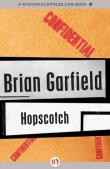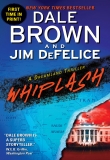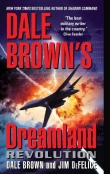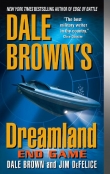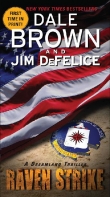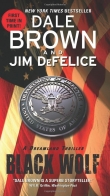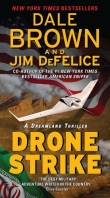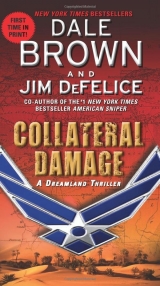
Текст книги "Collateral Damage"
Автор книги: Dale Brown
Жанры:
Боевики
,сообщить о нарушении
Текущая страница: 6 (всего у книги 25 страниц)
11
Sicily
Any aircraft would have felt a little strange to Turk after the Tigershark, but the A–10 was nearly as far removed from the F–40 as a warplane got.
The A–10A Thunderbolt had been something of a poor stepchild to the Air Force from the day of its conception. With straight wings and a cannon in its nose, the aircraft was the antithesis of the go-fast, push-button philosophy that ruled the U.S. Air Force in the late 1960s—and in fact, still largely ruled it today.
The Hog was born out of a need for a close-in, ground attack aircraft. While the country at the time was fighting in Vietnam, the perceived enemy was the Soviet Union, and the early design specs anticipated an aircraft that could be used to stop a massive tank invasion across the European plains. The plane was inspired partly by the success of the A–1 Skyraider—a highly effective throwback used to great effect in Vietnam, despite its alleged obsolescence. The “Spad,” as the A–1 was often nicknamed, was powered by a piston engine. Its primary asset—beyond the tough resourcefulness and skill of its pilots—was its ability to carry a large variety of ordnance under its wings. Clean, the Spad was comparatively fast for a piston-powered plane, but it was slow compared to jets. As a ground support aircraft, however, the lack of speed was something of an asset. In the days before complicated sensors and constantly updating satellite imagery, ground support relied heavily on the so-called Mk–1 Eyeball. Human pilots flying low and slow had a much better chance of putting the era’s unguided ordnance on target than fast-movers rocketing over the terrain.
The A-X project produced two aircraft sharing the same philosophy, both designed essentially around an armor-pounding, 30mm Gatling. The A–10 by Republic eventually won out. (The loser, the YA–9 built by Northrop, became the answer to a trivia question rarely asked of anyone, including plane buffs.)
The A–10 was designed and built in an era of tight budgets, and some say that the penny pinching hurt the plane from the very beginning. It was strictly a daytime, good-weather aircraft, with effectively no ability to fight at night: a critical oversight given the evolution of war-fighting doctrine in the years that followed, not to mention the fact that war generally takes place in all sorts of weather. And many critics pointed out that its engines were somewhat underpowered from the beginning. This was important not so much because it lowered the aircraft’s speed—speed wasn’t a real factor for the A–10A—but because the power of the engines limited the weight it could carry into the sky and the endurance of the aircraft.
A series of improvements in the last decade addressed the first set of drawbacks, adding enough modern sensors to the A–10A airframe that the planes had been redesignated the A–10C by the Air Force. While the plane remained essentially the same from the outside, inside the pilot’s “office” there were new displays and a data link that gave the Hog driver access to real-time combat information. The updated Hogs could also carry more modern “smart” weapons, including JDAM, or Joint Direct Attack Munitions.
Ginella’s eight planes were a further evolution. The upgraded avionics systems were tied to smart helmets, which functioned similarly to Turk’s—the pilots could use those helmets rather than the glass cockpit. There were certain subtle improvements—there was now a full-blown autopilot, separate from the remote link—and more obvious ones: uprated power plants that allowed the planes to carry even heavier bomb loads. The Hogs were still subsonic, but they had noticeably more giddy-up when accelerating. According to the stats, they had approximately forty percent more power, but used about a third less fuel under normal conditions.
The stats reminded Turk of EPA estimates on cars—always to be taken with a grain of salt—but there was no denying that the A–10E was a more powerful beast than its cousins.
At the same time, the plane remained an easy aircraft to fly. She just loved being in the air.
Sitting at the end of the runway, Turk got clearance and ramped the engine. The Hog galloped forward, gently rising off the concrete after he had gone only 1,200 feet—a better rollout than most other aircraft he’d flown.
He cleaned his landing gear, then following the controller’s directions, flew north over the Mediterranean to an airspace cleared of traffic.
Turk’s A–10E helmet duplicated the glass cockpit a pilot saw in an A–10C, and though it didn’t have quite the customization he was used to, it was nonetheless easy to deal with. The center of the board had the familiar attitude indicator, a large floating ball that told the pilot where his wings were in relation to the world—not always something that came intuitively, especially in battle. The heading indicator just below showed where the nose was going—again, an all-important check for the senses. To their right and slightly above, the climb indicator and altimeter did the obvious; a row of clock-style gauges at the lower right showed the aircraft’s vitals.
Ironically, the least familiar parts of the pseudocockpit for Turk were the most modern. The multiuse displays had a number of different modes, which he stumbled through slowly as he made sure he was familiar with the aircraft. The data transfer system, the embedded GPS navigation, and even the status page—a computer screen detailing system problems—were far different than what he was used to in the Tigershark. He had only to say a few words to get a response in the sleek F–40; here, he had to punch buttons and think about what he was doing.
But even hitting those buttons and occasionally pausing over the screens couldn’t detract from the solid feel of the aircraft around him.
Planes had a definite soul, basic flight characteristics that they seemed to come back to no matter the circumstances. The Tigershark moved quickly. She turned quickly, and she went forward quickly. Given her head, she accelerated. This could certainly get her in trouble—a quick flick of the wrist on the stick, and the plane could pull more g’s than Turk could stand.
The Hog’s nature was completely different. She was more a solid middle linebacker than a fleet receiver. Not to say she wasn’t nimble: she could dance back and forth, even sideways, as a few minutes of experimentation with her rudder pedals showed him. But her true nature was stability. Beat her into a turn, abuse her into a dive, jab her into a sharp climb—she came back gentle and solid.
The original A–10s were designed to be reliable, predictable weapons platforms, and the changes had left that completely alone. Try as Turk did to abuse it, the plane kept coming back for more. It went exactly where he pointed it, never overreacting to his control inputs.
In fact, Turk had so much fun putting the aircraft through its basic paces that he felt almost disappointed when it was time to land. The only consolation was that another Hog was sitting on the tarmac near the hangar waiting for him.
“All your controls solid, Captain?” asked Ginella, who walked over to the plane as he descended the ladder.
“They were kick-ass,” he told her, hopping down.
“Good. Don’t break this next one. They had a little trouble with the indicators on the starboard engine,” she added, her voice instantly serious. “Be gentle, all right? We don’t want to give the SAR people too much work this afternoon.”
“Gentle is my middle name,” he told her.
“I’ll bet you say that to all the women,” bellowed Beast, who walked over from behind the plane.
“Play nice now,” said Ginella. “Captain Mako, Beast is going to check out Shooter Four while you’re in Six. Don’t let him trip you up.”
“I’ll try to stay out of his way,” said Turk.
A few hours later Turk tested the engines on the ramp, his brakes set to hold him in place. If there had been an actual problem with the jet, there was no sign of it now. The instruments said the power plants were smooth and ready, and his gut agreed.
With Beast following in his trail, Turk took the aircraft skyward. All of the indicators were pegged at showroom stats, systems as green as green could be.
When they reached their testing area, Turk took a long circle around his airspace. He told Beast to stand by, then spooled the starboard engine down. The Hog didn’t entirely welcome flying on one engine, but she complied, reacting like a calm, indulgent workhorse. The plane jumped a bit when he brought the engine back on line, but there was no drama, no emergency. Nor did anything untoward happen when he flew on only the starboard motor.
“I think we’re good,” he told Beast.
“Hey yeah, roger that,” replied the other pilot. “How do you like the Hog?”
“It’s nice. I like it a lot.”
“As good as that little go-cart you fly?”
“The Tigershark is a special plane,” said Turk.
Beast laughed. “Fly with us enough and you’ll think the Hog is, too.”
“Shooter Four, Shooter Six, be advised you have two aircraft heading toward Box Area Three,” said the controller, alerting them to an approaching flight. “Call sign is Provence.”
A few seconds later Provence leader checked in. The planes were a pair of Rafale C multirole fighters. The Frenchmen had just arrived in Sicily.
“What are you up to, Provence leader?” asked Beast.
“Just getting some flight time and checking our systems,” responded the flight leader.
Turk saw the two planes approaching from the southwest. The Rafales were delta-wing fighters, developed by France in the late 1980s and early 1990s. Originally conceived as air superiority fighters, they had retained those genes as they matured to handle a variety of other roles. While the aircraft might not match American F–22s, they were nonetheless extremely capable dogfighters. In fact, in a close-range knife fight against a Raptor, the smart money would be on the Frenchmen; much smaller than the F–22, they could turn tighter and fly extremely slow: a little appreciated value in an old-fashioned fur ball.
Of course, any Raptor pilot worth his salt would have shot them down at beyond-visual range, but where was the fun in that?
“You boys looking for a little practice?” asked Beast.
“Pardon? Excusez?” said the French leader. “What is it you are asking?”
“Let’s see what you can do,” said Beast. He pushed his throttle and pointed the nose of the A–10E upward, in effect daring the Rafale to follow.
An “ordinary” Hog would have more than a little difficulty going nose up in the sky, but the enhanced power plants in Shooter Four brought her into a ninety degree climb almost instantly. Turk watched as the Rafales swung over to follow. Though caught a little flat-footed—a challenge from the ungainly Hogs must have been the last thing they expected—the two French fighters soon began to catch up, angling toward the A–10’s path. Then, just as it looked as if they would complete an intercept and put themselves in a position to wax Beast’s fanny, the Hog fell off hard to the right, diving down toward the purple-blue of the ocean.
Again the Frenchmen were caught off-guard. By the time they started to react, cutting off the climb and circling to the east, Beast had recovered and was looping underneath them.
From where Turk was flying, it was hard for him to see if Beast ended up on one of the Frenchman’s tails, but Beast’s laughter over the radio sure made it seem as if he had.
“Ya gotta watch out,” he told the Frenchman. “This is not your daddy’s Warthog.”
Turk turned his plane toward the others, waiting as the Rafales broke away. There was no way Beast could keep up, and so he didn’t, climbing merrily and then circling back to the south as they spun away.
The two French fighters regrouped at the north end of the box they had been given to fly in, then banked back toward the Warthog in a coordinated attack. The truth was, a radar missile at this range would have meant the end of the Hog and its guffawing pilot, but that wasn’t in keeping with the spirit of the encounter. As the Rafales moved in, they separated nicely, one high, one low, one to the east and one to the west, basically positioning themselves to cover anything Beast tried to do.
But that left the trailing wingman vulnerable to Turk, assuming he could accelerate quickly enough to make an attack. A “stock” A–10A couldn’t have managed it, but with the uprated engines, the refurbished Warthog had just enough giddy-up to pull it off. Turk jammed his throttle and pointed the A–10E’s nose at the Rafale’s tail, pulling close enough to have spit a dozen pellets of depleted uranium into the Frenchman’s backside before Provence Two realized where he was.
The Armée de l’Air pilot’s first reaction was to try to turn—he was hoping to throw the Warthog in front of him, essentially turning the tables. But the Hog was at least as good at slow-speed flying as the Rafale was, and Turk was able to dial back his gas just enough to stay behind the other plane. Only when the Rafale put the pedal to the metal and accelerated was he able to shake his sticky antagonist.
Beast was having a bit of difficulty shaking the other pilot, who wisely kept just enough distance to shadow the Hog without getting too close. The front canards on the Rafale—small winglets that added greatly to its maneuverability—worked overtime as the French flight leader remained figuratively on Beast’s shoulder. The two planes’ speed dropped down toward 100 knots—extremely slow, even for the straight-winged Hog. Still, the French-built fighter was able to hang in the air, a tribute both to the man at the stick and the gentlemen who had designed her.
Turk cut in their direction, making sure to clear over them by several thousand feet. A few touches on his trigger and the Frenchman would have had his pain buttered.
“OK, OK,” said the French flight leader. “Knock it off.”
“You owe us drinks,” laughed Beast.
The Frenchmen were good sports, promising that they would pay off at their earliest opportunity. They also added that they would have beaten the two Americans in anything approaching a fair fight.
“That’s your first mistake,” said Beast. “Never, ever fight fair.”
Ginella was waiting for them at their parking area when they returned.
She was not happy.
“What the hell did you think you were doing?” she said to Beast as he stepped onto the tarmac. “Where do you think you were, kindergarten? That action was dangerous and unauthorized. It was completely against regulations and, damn it, common sense!”
“I, uh—”
“Don’t speak,” she snapped. She turned to Turk. “And you—you! You’re a test pilot. An engineer.”
“Well, no, I—”
“Is this what they teach you at Dreamland? I’m really disappointed in you, Captain. Really disappointed. I’ve seen your record—you’re supposed to be a mature pilot with a good set of decision-making skills. Quote, end quote.”
Turk wanted to shrink into the macadam below his feet. She was absolutely right to bawl him out, and he knew it. He kept his eyes fixed on the ground as she continued, giving him one of the sternest lectures he had ever received.
“What do you have to say for yourself?” she asked finally.
“I was stupid,” he said. “I lost my head and acted like a jerk.”
“Get out of here before I do something rash,” she said. “Report to the maintenance officer.”
Beast took a step to leave. Ginella whirled toward him. “You and I are not done.”
“Yes, ma’am,” said Beast softly.
Turk didn’t hang around to hear the rest. He practically ran to get out of his flight gear, then quickly made his way to the squadron’s offices.
“Colonel talked to you?” asked the major sitting at the desk when he came in.
Turk nodded.
“I assume the plane checked out.”
“Yes.”
They went over the flight quickly. Turk wanted to finish as quickly as possible, hoping to avoid seeing Ginella again.
No such luck, though. She was standing in the doorway when he finished.
“Give us a minute, Major?” she snapped. It wasn’t a question.
“Wanted to grab a coffee,” said the officer, who quickly slipped past her.
“I’m sorry,” said Turk, sitting back in his seat. “I know I was out of line. I know it.”
She frowned, but the quick admission of guilt seemed to take a little of her anger away. She went over to the desk the major had been using and sat behind it.
“I realize that I run things a little loose at times,” she told him. “On the ground. Yes. But that doesn’t mean it’s OK to act like a cowboy in my squadron. In the air, we are all business. Do you understand that?”
“I know. I was totally out of line.”
She stared at him. Her eyes were a light blue with small wrinkles of brown in them, as if the blue were tiny pages of a book arranged one on top of the other around the pupil.
“You’re a good pilot, at least,” said Ginella finally.
“Thank you.”
“I wouldn’t grin.”
“No.” Turk shook his head.
“All right, Captain. You can go.”
Turk rose and started to leave.
“Thank you for helping us,” said Ginella.
Turk turned around.
“It was my pleasure,” he said.
“Good.”
He left the room chastened, but unbroken.
12
Sicily
“It’s not possible that the Sabre didn’t know where it was.” Brad Keeler thumped his hand against the wall, tapping the map image projected there. “We have the GPS data all the way through.”
“And it functioned optimally?” asked Rubeo. “You’re positive of that?”
“As positive as we can be.”
“Was there interference through the control channel?”
Keeler pursed his lips. The one vulnerability of all unmanned aircraft systems was their reliance on external radio signals, for control and navigation. Much progress had been made in the area over the past decade but it remained at least a theoretical vulnerability.
“We don’t believe so,” said Keeler, weighing his words. “It would fail-safe out. Even if it were done very well, we should have a trace somewhere in the system.”
“The GPS?”
“GPS is trickier to track,” admitted Keeler. The Sabre got reads on where it was by querying the global position satellite system. In theory, the system could be fooled or even infiltrated. But it was difficult to do technically.
“Harder to catch,” noted Marcum.
“Absolutely,” admitted Keeler. “But there should be some trace of that.”
“Simple interference?” asked Rubeo.
“Again—it’s theoretically possible. But if so, they’re doing it in a way that we haven’t seen before. And the NATO sensors didn’t pick up any direct interference.”
“They hardly know what to look for,” said Rubeo. Interference in this case meant some sort of radio jamming, which generally was fairly obvious but could be done very selectively. In fact, Rubeo’s companies were working on a system that jammed only select aircraft—in theory, one could confuse a single UAV in a flight, turning it against its fellows.
Only in theory, so far. The Libyans naturally would be unable to do this on their own. But there were plenty of people who might want to take the chance to test their systems in the field.
Rubeo couldn’t control his agitation. He rose. “A virus?” he asked.
“So far, no trace. And it would have to be introduced physically. Which means by someone on the team.”
“Or someone who has access to the hangar,” said Rubeo. “Or the transports. Or one of the bases where they stopped. Or—”
“Point taken.”
“I want to know exactly what happened,” he said. “We need to know.”
“We are working on it,” said Marcum, rescuing Keeler. “We haven’t been at it all that long. Barely twenty-four hours.”
“I’ve been here less than twelve,” said Keeler.
Rubeo pressed his hands together. “The government planes? What’s the connection there?”
“At best, a diversion,” said Marcum. “More likely a coincidence.”
“Did they jam?”
“No,” said Keeler. “No jamming was recorded by any of the aircraft, including the Tigershark.”
“But there were ECMs,” said Rubeo. “They might have covered it. That would explain why the government attacked in the first place.”
Marcum looked as if he had just sucked a lemon.
“We’ve mapped all of the radars in the area,” said Keeler. “It’s possible there was another one. But if it was interfered with, we can’t figure out what the interference form would have been.”
“These are early days, Ray,” said Marcum. “We will get there. We have to build up slowly.”
“How well are you sleeping?” Rubeo snapped.
Marcum didn’t answer.
“We all want to figure out what happened, Dr. Rubeo,” said Keeler gently. “We will figure it out.”
“I can’t sleep at all,” said Rubeo.
